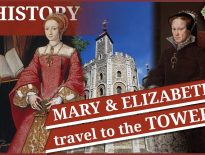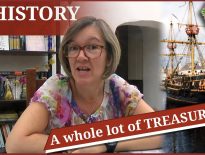On this day in Tudor history, 27th September 1501, Catherine of Aragon, daughter of Ferdinand II of Aragon and Isabella I of Castile, set sail for England from Laredo, Spain.
Catherine was leaving her homeland to marry Arthur Tudor, son and heir of King Henry VII, a marriage arranged by her parents and the English king in the Treaty of Medina del Campo.
This was Catherine's second attempt at sailing to England, but this time she was successful.
I explain the background to Catherine's journey, along with what happened when she first set sail in August 1501.
Also on this day in history:
- 1442 – Birth of John de la Pole, 2nd Duke of Suffolk, to William de la Pole, 1st Duke of Suffolk, and his wife Alice (née Chaucer). Suffolk married the six year-old Margaret Beaufort, future mother of Henry VII, in 1449, but the marriage was annulled by Henry VI in 1453, and he went on to marry Elizabeth, daughter of Richard of York and sister of Edward IV.
- 1488 – Death of William Hobbes, physician and surgeon. He was buried in Holy Trinity Priory, Aldgate, London. Hobbes served Richard, Duke of York, and Edward IV, and was Royal Physician to Richard III. He became Master of St Mary of Bethlehem Hospital (Bedlam) in 1479.
- 1540 – Birth of Michael Heneage, politician and antiquary. Heneage was a member of Parliament, a Keeper of the Records in the Tower of London, and a member of the Society of Antiquaries.
- 1571 – Death of Sir William Garrard, merchant, in London. He was buried in the church of St Magnus the Martyr near London Bridge. Garrard was Mayor of London in 1555, and a member of Parliament during Mary I's reign. He also went on voyages to Guinea in the 1550s and 1560s, and became a consul of the Russia Company in 1553.



Poor Catherine and poor all young Princesses having to make long and hard journeys to another country and also knowing they probably wouldn’t see their families again. They may have been raised for this, training from small children, but they didn’t know how their partners would treat them, the people accept them, if they would die in childbirth, they had to find a neutral language and learn new ones, cultural differences, political differences, even resentment if the marriage followed years and years of warfare, which is what happened to fifteen year old Margaret of Anjou, wife of King Henry V; these poor young ladies had such pressures on them. The spouse too must have been apprehensive, especially as the heir to a new Dynasty. Older royal spouses found it hard enough; Katherine and Arthur were just fifteen. It was another world.